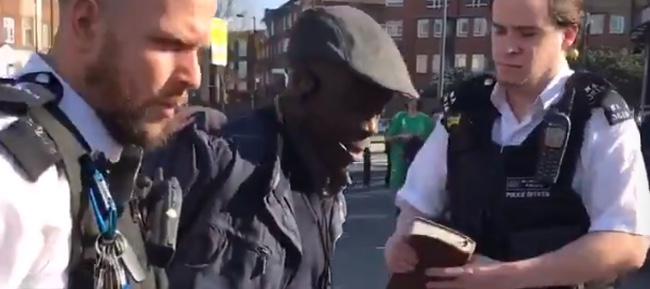
Following the recent arrest of a street preacher in London a number of people have rung or emailed to ask for advice with regards the offense of “Breach of the Peace.” The following advice was provided by “Christian Concern.”
Breach of the peace is not defined in statute as it is a common law concept. The accepted definition is found in case law * and defined thus – the behaviour of the person involved caused the police officer to believe that:
1. a breach of the peace had or would occur; and that
2. it related to harm which was actually done or likely to be done to a person or, in his presence, their property
From this definition we can conclude that as most street preachers are unlikely to ever be using violence against a member of the public, it is more likely that a member of the public is threatening violence and so the preacher could be expected to be protected by a police officer.
When faced with a breach of the peace most police officers use their common law power of arrest and tend to use their powers under the Public Order Act. The most commonly used section is Section 4. See below.
Section 4:
Fear or provocation of violence.
(1) A person is guilty of an offence if he—
(a) uses towards another person threatening, abusive or insulting words or behaviour, or
(b) distributes or displays to another person any writing, sign or other visible representation which is threatening, abusive or insulting,
with intent to cause that person to believe that immediate unlawful violence will be used against him or another by any person, or to provoke the immediate use of unlawful violence by that person or another, or whereby that person is likely to believe that such violence will be used or it is likely that such violence will be provoked.
(2) An offence under this section may be committed in a public or a private place, except that no offence is committed where the words or behaviour are used, or the writing, sign or other visible representation is distributed or displayed, by a person inside a dwelling and the other person is also inside that or another dwelling.
(4) A person guilty of an offence under this section is liable on summary conviction to imprisonment for a term not exceeding 6 months or a fine not exceeding level 5 on the standard scale or both.
The other commonly used measure is a section 35 dispersal notice which gives the Police powers to remove someone from an area with an order not to return within 48 hours. Section 35 is quoted below.
Anti-social Behaviour, Crime and Policing Act 2014
Section 35 Directions excluding a person from an area
(1) If the conditions in subsections (2) and (3) are met and an authorisation is in force under section 34, a constable in uniform may direct a person who is in a public place in the locality specified in the authorisation—
(a) to leave the locality (or part of the locality), and
(b) not to return to the locality (or part of the locality) for the period specified in the direction (“the exclusion period”).
(2) The first condition is that the constable has reasonable grounds to suspect that the behaviour of the person in the locality has contributed or is likely to contribute to—
(a) members of the public in the locality being harassed, alarmed or distressed, or
(b) the occurrence in the locality of crime or disorder.
(3) The second condition is that the constable considers that giving a direction to the person is necessary for the purpose of removing or reducing the likelihood of the events mentioned in subsection (2)(a) or (b).
(4) The exclusion period may not exceed 48 hours.
The period may expire after (as long as it begins during) the period specified in the authorisation under section 34.
(5) A direction under this section—
(a) must be given in writing, unless that is not reasonably practicable;
(b) must specify the area to which it relates;
(c) may impose requirements as to the time by which the person must leave the area and the manner in which the person must do so (including the route).
(6) The constable must (unless it is not reasonably practicable) tell the person to whom the direction is given that failing without reasonable excuse to comply with the direction is an offence.
(7) If the constable reasonably believes that the person to whom the direction is given is under the age of 16, the constable may remove the person to a place where the person lives or a place of safety.
(8) Any constable may withdraw or vary a direction under this section; but a variation must not extend the duration of a direction beyond 48 hours from when it was first given.
(9) Notice of a withdrawal or variation of a direction—
(a) must be given to the person to whom the direction was given, unless that is not reasonably practicable, and
(b) if given, must be given in writing unless that is not reasonably practicable.
(10) In this section “public place” means a place to which at the material time the public or a section of the public has access, on payment or otherwise, as of right or by virtue of express or implied permission.
(11) In this Part “exclusion period” has the meaning given by subsection
* The case of R v Howell [1981]
Many thanks for this information to the:
Christian legal Centre
70 Wimpole Street
London W1G 8AX
020 3327 1130








